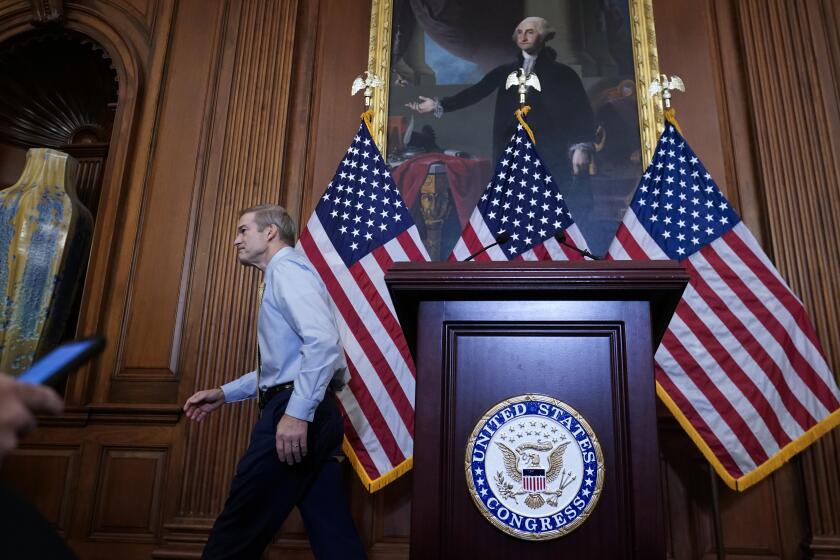Column: 2023 was the year I started believing in the horseshoe theory of politics

- Share via
This is the season for columnists to offer some new idea that encapsulates the year that was. I got nothing. But 2023 was the year I finally abandoned my opposition to an old idea — the horseshoe theory of political ideologies.
The term is often attributed to French author Jean-Pierre Faye‘s 1996 book “Le Siècle des ideologies” (“The Century of Ideologies”), but the concept is much older. It basically holds that the extreme right (“fascism”) and extreme left (“communism”) bend toward each other like the ends of a horseshoe.
It might sound like just another outlandish remark from Donald Trump, Republican presidential front-runner, but it’s easy for politicians to mislead when so many people want to be misled.
While totalitarian regimes — Stalin’s Russia, Hitler’s Germany — have more similarities than differences, the horseshoe theory hasn’t mapped well in the American context. (It is, after all, born from the seating chart of the French National Assembly.) In the continental political tradition, right-versus-left fights were more about how to use state power, not how to limit it. Between those two sides, there was little dispute over the notion of statism.
Meanwhile anti-statism, including an ornery passion for civil liberties — i.e., classical liberalism — has always been a core component of American exceptionalism. Indeed, left and right in U.S. politics often become less statist as they become more extreme. Wanting to abolish government agencies, privatize or deregulate state functions, was a hallmark of the American right; it’s hard to see how becoming more libertarian makes you more “fascist.”
A new book argues that Democrats’ extreme framing of issues such as race, immigration and climate change turns off more voters than it attracts.
The American left has an anti-statist streak too. Defunding the police, legalizing drugs, open borders, decriminalizing prostitution, abolishing the “prison industrial complex” — all are more anarchic than statist. True communists like their cops and prisons.
In short, while the American left and right have always had plenty of disagreements, they usually were hashed out within the framework of America’s deep-seated classical liberalism. But what happens when the extremes abandon that liberalism? They start looking awfully similar.
For instance, few extremists from either pole really oppose cancel culture or censorship; they just want the ability to cancel or censor people or ideas they don’t like. Donald Trump is a zealous advocate for his free speech rights but holds nearly opposite views for his critics.
Will the House GOP learn from the last week? Speakers are supposed to be traffic cops, not ideological firebrands.
The left and right may see huge differences between left-wing identity politics and right-wing identity politics — and there are huge differences — but the notion that individuals should be judged by what groups they belong to is profoundly illiberal.
Perhaps the most discomforting convergence is over the Constitution. The Federalist Society, with its deeply conservative and passionate commitment to constitutional fidelity, has always been a bulwark of classical liberalism because the Constitution is a quintessentially liberal charter. Indeed, that’s why Trump reportedly has turned his back on disloyal Federalist Society lawyers — many of whom wouldn’t aid his effort to steal the election — in favor of MAGA pettifoggers happy to treat the Constitution like an illegitimate law they can help their client wiggle out of.
There’s a new right-wing project called “common good constitutionalism,” which seeks to dethrone the Federalist Society and abandon constitutional originalism in favor of a results-driven approach to the law and the Constitution.
Some on the left might object, but from my perspective as a traditional conservative, that approach mirrors the left’s invocation of a “living constitution” to defeat constitutional interpretations it doesn’t like.
Of course, some of these trends are very old. What’s changed is how much more willing the political center is to let itself be defined by the logic and rhetoric of the extremes. The result is a kind of bipartisan consensus around the more European idea of fighting for control of the state, led by politicians terrified of their bases.
Why the rhetoric of the fringes has become mainstream probably has a lot to do with the changing media landscape and weakness of parties. But what remains constant is the importance of rhetoric itself, which, as literary critic Wayne Booth said, is “the art of probing what men believe they ought to believe.” And the loudest voices are bending the arc of our politics toward illiberalism.
More to Read
A cure for the common opinion
Get thought-provoking perspectives with our weekly newsletter.
You may occasionally receive promotional content from the Los Angeles Times.














